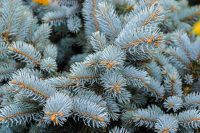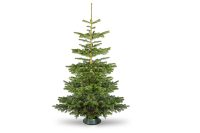Fraser fir (Abies fraseri) is non-toxic to dogs and is safe to keep in homes with pets as long as precautions are taken.
What is Fraser fir?
| Family | Pinaceae |
| Botanical name | Abies fraseri |
| Common names | Hickory pine, White spruce, Green spruce, Silver spruce, Colorado spruce |
| Mature height | 25 metres (82 foot) |
| Needle retention | Excellent needle retention |
| Scent | Woody, mild citrus |
| Native to | Appalachian mountains of the eastern United States |
| Toxicity | Non-toxic |
Fraser fir is a popular choice for a Christmas tree due to its pyramid shape, fresh fragrance and soft needles. Named after Scottish botanist John Fraser, the Fraser fir is native to the Appalachian mountains of the eastern United States and is a close relative to balsam fir.
Toxicity
Fraser fir is non-toxic to cats. However, ingestion of large quantities can cause gastrointestinal upset. The bitter taste will deter most dogs from ingesting a large amount.
What should I do if my dog chews Fraser fir?
If it is safe to do so, carefully remove any remaining plant matter from the dog’s mouth and offer a drink of something tasty such as milk. Ingestion of a few needles should not be a serious risk, but large ingestions do have the potential to cause issues. If your dog has consumed any part of Fraser fir, keep a close eye on the dog and if symptoms such as drooling or vomiting develop, seek veterinary attention.
Signs you should see a veterinarian
Seek veterinary attention if the dog develops clinical signs such as loss of appetite, drooling or vomiting. While Fraser fir is non-toxic, ingestion of pine needles can damage the gastrointestinal tract.
Safety
With proper precautions, homes with dogs can enjoy live Christmas trees.
- Do not use tree preservers or aspirin in homes with dogs or cats which are toxic if ingested.
- Cover the drip tray to prevent pets from drinking the water. Even preservative-free water can harbour bacteria which can cause GI upset.
- Unplug Christmas tree lights when not in use.
- Secure Christmas trees to the wall with fishing line to prevent pets from knocking them over.
- Place breakable decorations higher up on the tree to prevent breakage and use twist ties to securely attach decorations to the tree.
- Do not hang food decorations on trees in homes with pets. Chocolate in particular is toxic to dogs.
- Block access to the tree with a baby gate, or place in a room that can be shut off.
- Avoid using decorations or lights which use button batteries which are deadly if ingested. Button batteries are not only a choking hazard but can burn a hole in the esophagus by isothermic hydrolysis.
- Unless the dog cannot access the tree, wait until Christmas morning to place presents under the tree.
- Before you bring your Fraser fir inside, give it a good drink of water to ensure it is well hydrated and shake it off to remove any loose needles.
Veterinarians see an increase in accidents and food-related illnesses Christmas period. Christmas should be a happy time for both humans and pets, but caregivers must remember that popular Christmas plants and foods can be hazardous to our pets.
Toxicity of common Christmas trees to dogs
Common name |
Scientific name |
Toxicity level |
| Norway spruce | Picea abies | Non-toxic |
| Blue spruce | Picea pungens | Non-toxic |
| Serbian spruce | Picea omorika | Non-toxic |
| White spruce | Picea glauca | Non-toxic |
| Nordmann fir | Abies nordmanniana | Non-toxic |
| Fraser fir | Abies fraseri | Non-toxic |
| Douglas fir | Pseudotsuga menziesii | Non-toxic |
| Noble fir | Abies procera | Non-toxic |
| Balsam fir | Abies balsamea | Non-toxic |
| Grand fir | Abies grandis | Non-toxic |
| Scotch pine | Pinus sylvestris | No information available |
| White pine | Pinus strobus | No information available |
| Virginian pine | Pinus virginiana | Toxic |
| Norfolk Island pine, house pine | Araucaria heterophylla | Non-toxic |
Julia is a writer and landscape consultant from Wollongong with a love of horticulture. She had been an avid gardener for over 30 years, collects rare variegated plants and is a home orchardist. Julia is passionate about learning and sharing her knowledge of plant propagation and plant toxicology. Whether it’s giving advice on landscape projects or sharing tips on growing, Julia enjoys helping people make their gardens flourish.




